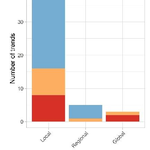Abstract
Empirical quantification of biodiversity changes remains a challenge even in well surveyed groups such as birds. This may be because the change depends on spatio-temporal scales, specifically on spatial grain (i.e. average unit of area of the sampling or the analysis), geographic extent (i.e. size of the area of interest), temporal grain (i.e. average unit of duration of the sampling or the analysis), and temporal extent (i.e. length of the time series). Further, different metrics of biodiversity may exhibit different trends.
Here we review the literature assessing the temporal trends of avian biodiversity from ca 1900 AD to present, focusing on studies summarising trends across many locations within a larger region (i.e. spatially replicated). From each study we extracted direction of average trend (increase, decrease, stable), spatial and temporal grains and extents at which the trends have been assessed, metrics of biodiversity, and location. We then discuss the trends as a function of the spatio-temporal grains and extents they are defined at. We found 59 trends of 12 metrics, where each trend is an average of trends from multiple sites (spatial replicates). There was a tendency of biodiversity metrics to increase at local and regional spatial scales, and to decrease globally. We thus confirmed that biodiversity dynamics can have opposite trends at different spatial scales.
Concerning temporal grain, it was poorly documented across the studies, with inconsistent and/or confusing definitions. We suggest a common framework to better understand the link between temporal scales and biodiversity dynamics. We have also identified underrepresented regions (those outside North America and Europe), periods (those before the 70’s), and biodiversity metrics that need further attention. We highlight the importance of considering both spatial and temporal scaling jointly in any assessment of biodiversity change, and provide guidelines for specifying spatio-temporal features (i.e. grain, lag and extent) effectively both in birds, and in other taxa.
